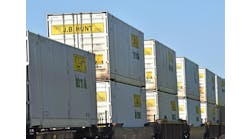“Building an omni-channel capability cannot be an afterthought.… Companies must embed omni-channel into their strategy, transform their supply chain to be truly agile and responsive, and build robust data and analytics capabilities.” —Ernst & Young
In the changing transportation landscape, traditional models are being replaced with a new set of constantly moving pieces. Driving these changes are disruptive economic issues that are causing shippers, carriers, brokers and third-party logistics providers (3PLs) to restructure and re-focus their businesses.
Among the changes is that for-hire carriers are increasingly offering dedicated, freight management and brokerage services. For private fleets, corporate pressure to reduce costs is driving the need to operate as for-hire carriers, and many are also acting as 3PLs by brokering loads to other companies. At the same time, brokers are providing a wider range of logistics services, and traditional non-asset based providers are acquiring assets to guarantee service.
Driving Forces
The rise of omni-channel sales is changing the supply chain. Retailers, wholesalers and manufacturers are now offering goods through multiple channels to provide a seamless customer experience.
Tasked with offering exceptional flexibility and service, retailers are providing immediate product availability for consumers by employing multiple shipping and delivery options. Consumers, for their part, now expect fast delivery that is either free or offered at greatly reduced rates. For example, five years ago, two-day shipping was only available for a substantial fee, in some cases more than cost of the product itself. Today, anything over two days is unacceptable, and free expedited shipping is often expected.
The driving force behind this trend is the Internet, and its inherent convenience is forcing retailers to provide online sales to remain competitive. In 2016, according to Fortune magazine, consumers for the first time shopped online more than at brick-and-mortar stores. E-commerce website design firm OuterBox says online sales totaled $327 billion in 2016, up 45% from 2015. Looking ahead, Forrester Research analysts predict a 9% average annual rate of growth in online sales over the next five years.
This increase in online shopping has forced retailers to reduce their physical footprints. In many cases, consumers are only using a store if they want to see a product before making a purchase, and they’ll often go online for the purchase after visiting a store.
Re-thinking Service Offerings
The growth of e-commerce and omni-channel supply chains is having a profound effect on transportation models and is forcing freight carriers to rethink and expand their service offerings. Setting high expectations for the transportation entities that haul their goods, retailers are demanding more frequent deliveries with smaller shipment sizes, and for very good reason.
Here’s an example:
If a retailer simply relied on a traditional cost-per-hundred weight or cost-per-pound metric, it would never be able to justify relying on a parcel network to deliver 25 cartons to a store. “They’ll just have to wait until the next LTL or multi-stop truckload shipment.”
But by looking at the sell-through rate and gross margin they are likely to earn through more frequent replenishment of popular items, the incremental revenue often far outweighs the increased transportation expense.
The emergence of omni-channel sales is having a transformative effect on how goods move through the supply chain, including traditional trucking moves involving raw materials to manufacturers, truckload moves from manufacturers to wholesalers or distributors, and truckload and LTL moves to retailers.
In the new supply chain, orders are shipped directly from the distributor and in some cases from the factory to the customer. To make it even more complicated, there are even viable models through which items are shipped from a retail store even though the order was placed online.
Omni-channel transportation models are disruptive to carriers and logistics services providers, regardless of which portion of the supply chain they serve. Carriers must be willing to adapt to the changing procurement arrangements established by retailers utilizing networks of dynamic distribution channels.
The New Transportation Model
Traditional carrier transportation models are not designed to handle the challenges of omni-channel service, which require multi-stop planning for last-mile deliveries and advanced scheduling capabilities, along with end-to-end visibility into order location and status for the customer.
As a distinct subset of omni-channel commerce, last-mile deliveries pose a different set of challenges that must be understood and met. These include more sophisticated planning for multi-stop routing, tight delivery windows and more frequent non-dock deliveries to residences and businesses.
For carriers and logistics companies, omni-channel service typically underutilizes capacity and requires more resources in an environment already fraught with a driver shortage and high costs for new equipment.
Because speed of delivery is imperative, a smaller distribution footprint is typically a requirement to provide cross-dock operations closer to customers, and there is a driving need for an inherently inefficient transportation model involving smaller, more frequent shipments.
Adapting to Challenges through Technology
For commercial motor carriers, understanding these challenges is the first step in determining what changes need to be made to their current transportation models. Successful carriers and logistics companies are adopting complex costing models to meet omni-channel needs. In many cases, however, the use of obsolete management methods and outdated planning processes and tools exacerbates the challenge of improving delivery performance in this changing environment.
In order to meet the delivery challenges inherent in omni-channel freight delivery, companies need a last-mile component in their transportation management systems (TMS). Few TMS’s today have the functionality to specifically address the unique needs required to operate in omni-channel and last-mile modes.
Simply using multiple software systems can be a concern if they are poorly integrated—or, more likely, not integrated at all. What’s required to be successful when addressing omni-channel and last-mile is a single, unified platform for integrated planning, dispatch and real-time visibility. Batch planning is a thing of the past. Today, it’s not as simple as matching a driver to a load, given that 15 trucks with 15 stops each create 1,800 possible load combinations. What’s required now is complex optimization that accounts for customer locations, product details, shipment sizes, time windows and equipment restrictions.
Exiting the Comfort Zone
The key to solving this puzzle is advanced analytics. Carriers and logistics companies are using complex costing models to profitably bid freight and to select the most effective transportation modes. Examining operating practices that might be outside their traditional comfort zone, they are using tools that capture detailed metrics to determine where service needs can converge with profitability.
Also essential is the ability to analyze data using business intelligence tools. Business intelligence provides historical and predictive views of operations that improve bid planning and strategic decision-making. Referencing data from multiple sources on operating, fuel, maintenance and driver costs can determine true profitability.
End-to-end visibility is also required. With customers demanding immediate status updates of each order, regardless of where it exists within the supply chain or who is handling it, shippers are adopting supply chain visibility platforms that are fully integrated with TMS solutions.
Successfully Navigating Uncharted Territory
The new delivery puzzle is uncharted territory for many carriers and logistics service providers as they strive to rise to meet the freight transportation challenges of a 21st century economy.
Only advanced transportation management systems designed for multi-stop deliveries and ever rising customer expectations can provide the capability, flexibility and tools to successfully meet the demands of omni-channel and last-mile delivery models.
James Stevenson is a vice president with TMW Systems, a provider of transportation management software. He was co-founder of Appian Logistics Software in 1987, which today represents the Appian FinalMile division of TMW.



